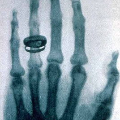Medical Visual Question Answering (VQA) systems play a supporting role to understand clinic-relevant information carried by medical images. The questions to a medical image include two categories: close-end (such as Yes/No question) and open-end. To obtain answers, the majority of the existing medical VQA methods relies on classification approaches, while a few works attempt to use generation approaches or a mixture of the two. The classification approaches are relatively simple but perform poorly on long open-end questions. To bridge this gap, in this paper, we propose a new Transformer based framework for medical VQA (named as Q2ATransformer), which integrates the advantages of both the classification and the generation approaches and provides a unified treatment for the close-end and open-end questions. Specifically, we introduce an additional Transformer decoder with a set of learnable candidate answer embeddings to query the existence of each answer class to a given image-question pair. Through the Transformer attention, the candidate answer embeddings interact with the fused features of the image-question pair to make the decision. In this way, despite being a classification-based approach, our method provides a mechanism to interact with the answer information for prediction like the generation-based approaches. On the other hand, by classification, we mitigate the task difficulty by reducing the search space of answers. Our method achieves new state-of-the-art performance on two medical VQA benchmarks. Especially, for the open-end questions, we achieve 79.19% on VQA-RAD and 54.85% on PathVQA, with 16.09% and 41.45% absolute improvements, respectively.
翻译:医学视觉问答(VQA)系统在理解医学图像所包含的临床相关信息方面扮演了支持性角色。针对医学图像的问题包括两类:闭合问题(如是/否问题)和开放性问题。现有的大多数医学VQA方法依赖于分类方法来获得答案,而有些方法则试图使用生成方法或两者的混合方法。分类方法相对简单,但在长开放问题上表现不佳。为了弥补这一差距,在本文中,我们提出了一种新的基于Transformer框架的医学VQA方法(称为Q2ATransformer),它集成了分类和生成方法的优点,并为闭合问题和开放问题提供了统一的处理方法。具体而言,我们引入了额外的Transformer解码器和一组可学习的候选答案嵌入,以查询是否存在给定图像-问题对的每个答案类别。通过Transformer注意力机制,候选答案嵌入与图像-问题对的融合特征交互以做出决策。通过这种方式,尽管属于基于分类的方法,我们的方法提供了一种与答案信息进行交互以进行预测的机制,类似于基于生成的方法。另一方面,通过分类,我们通过减少答案搜索空间来减轻任务难度。我们的方法在两个医学VQA基准测试中取得了新的最佳性能。特别是对于开放性问题,我们在VQA-RAD上取得了79.19%,在PathVQA上取得了54.85%,分别提高了16.09%和41.45%的绝对值。



